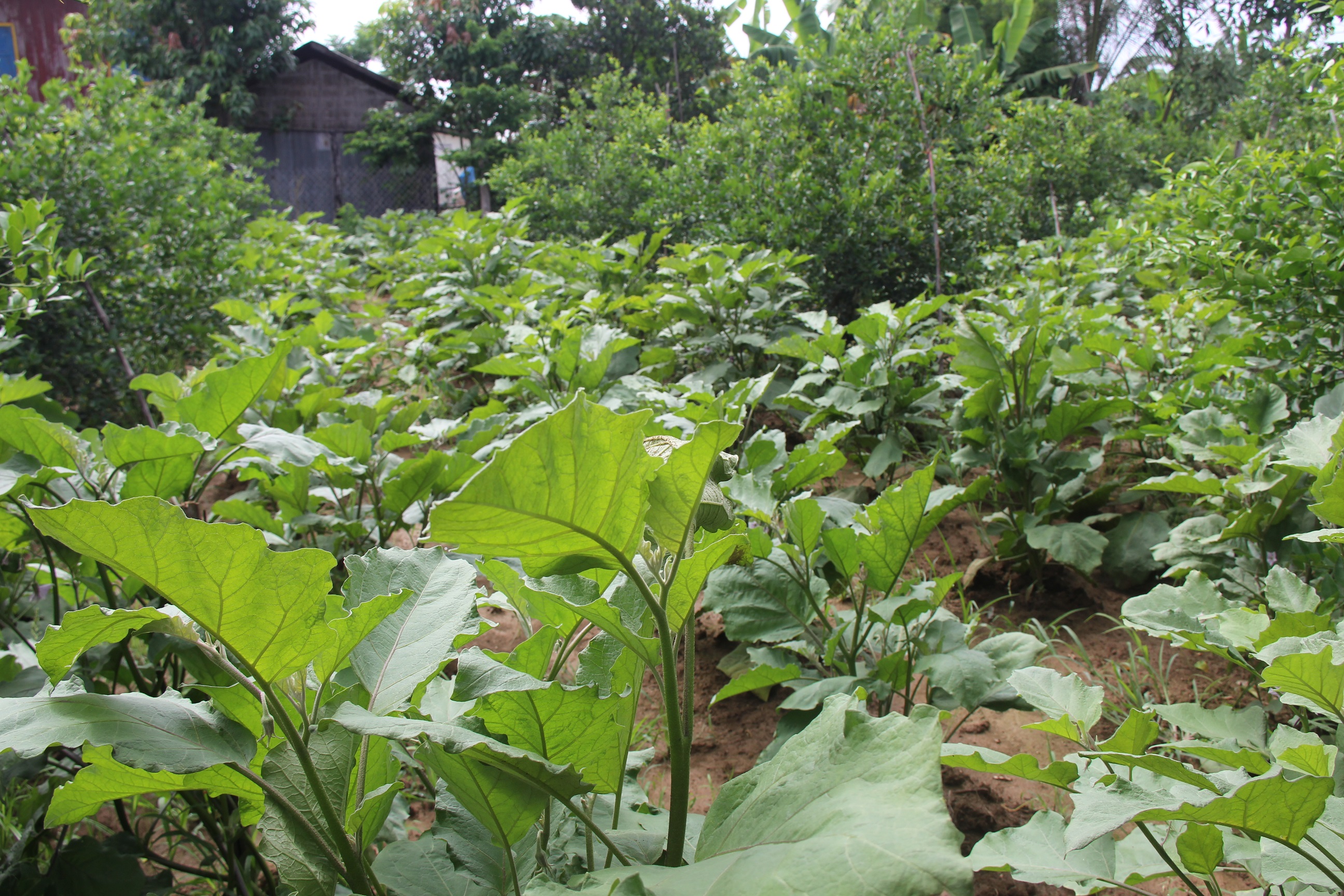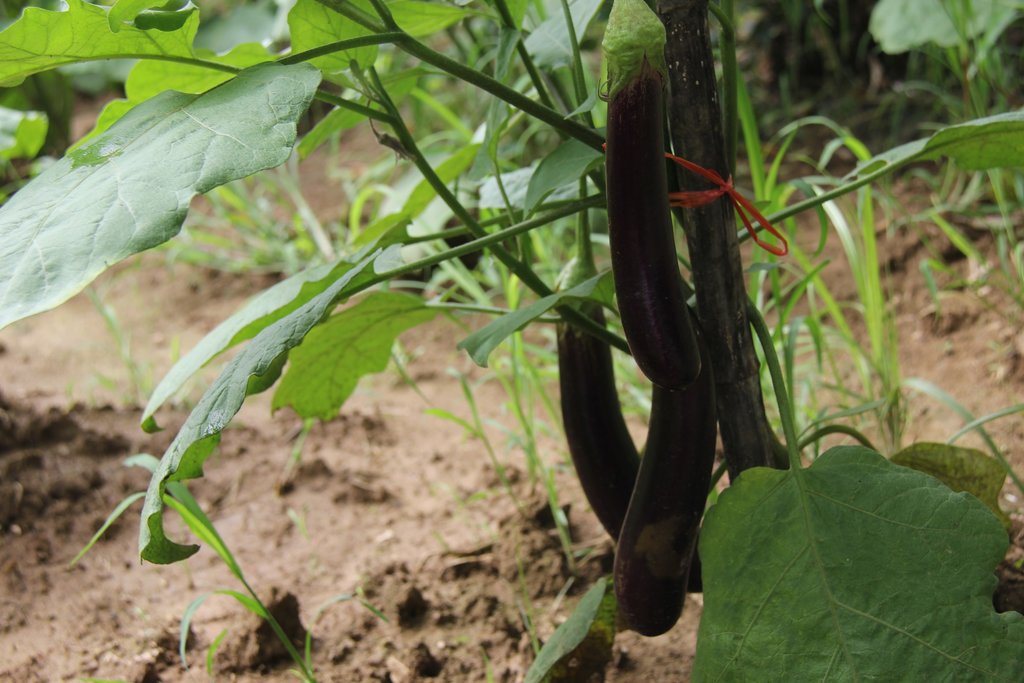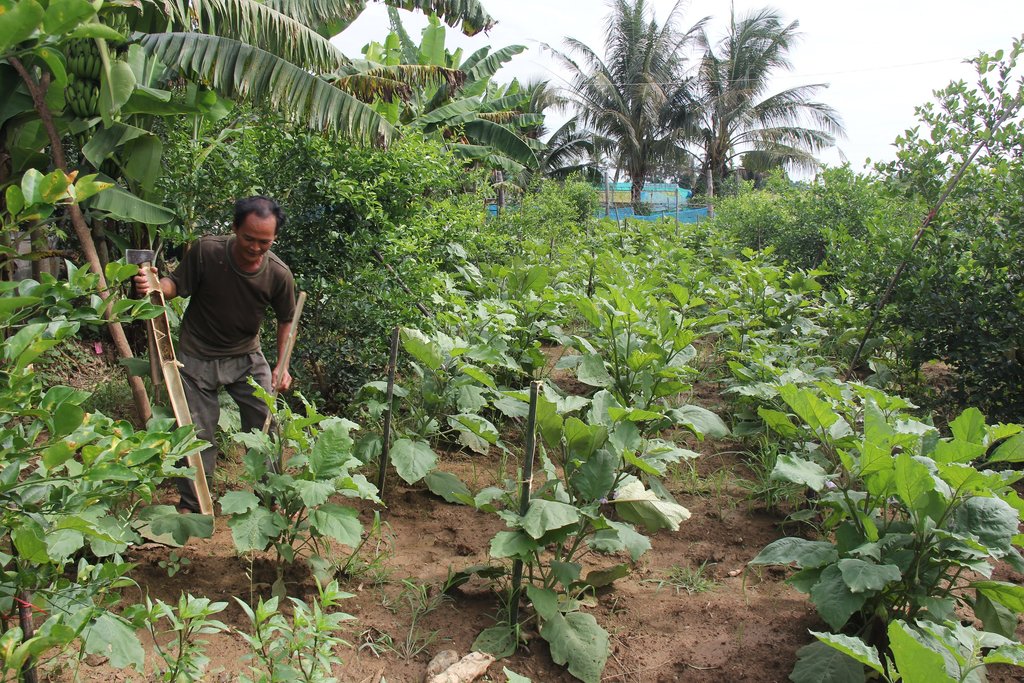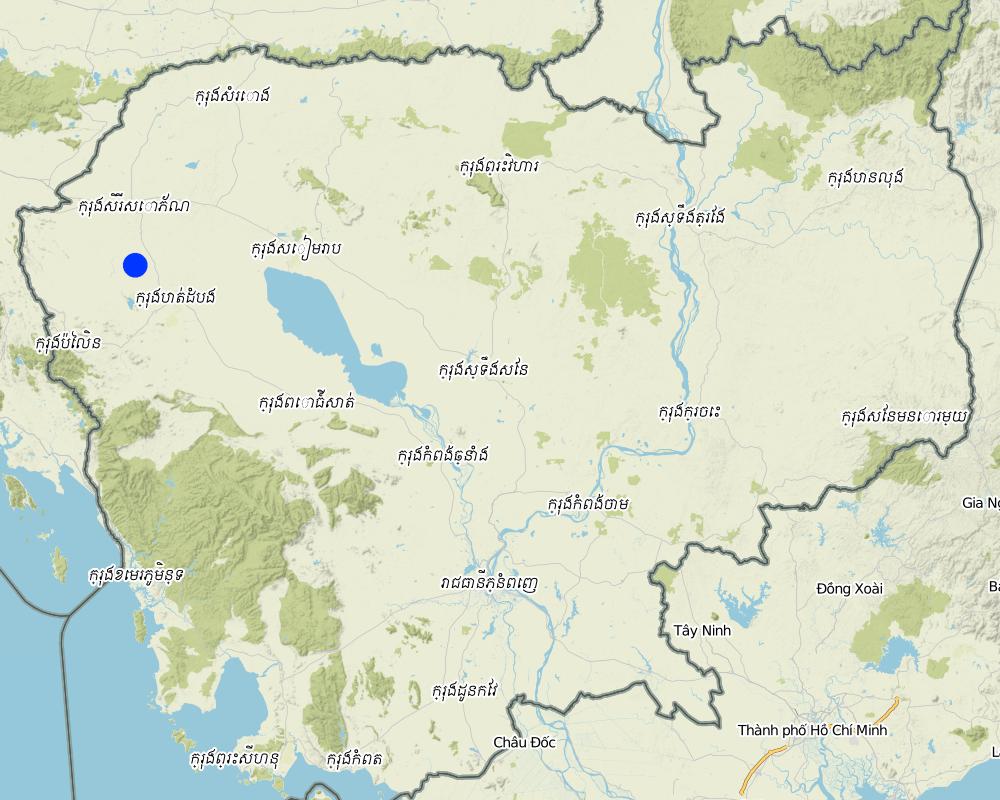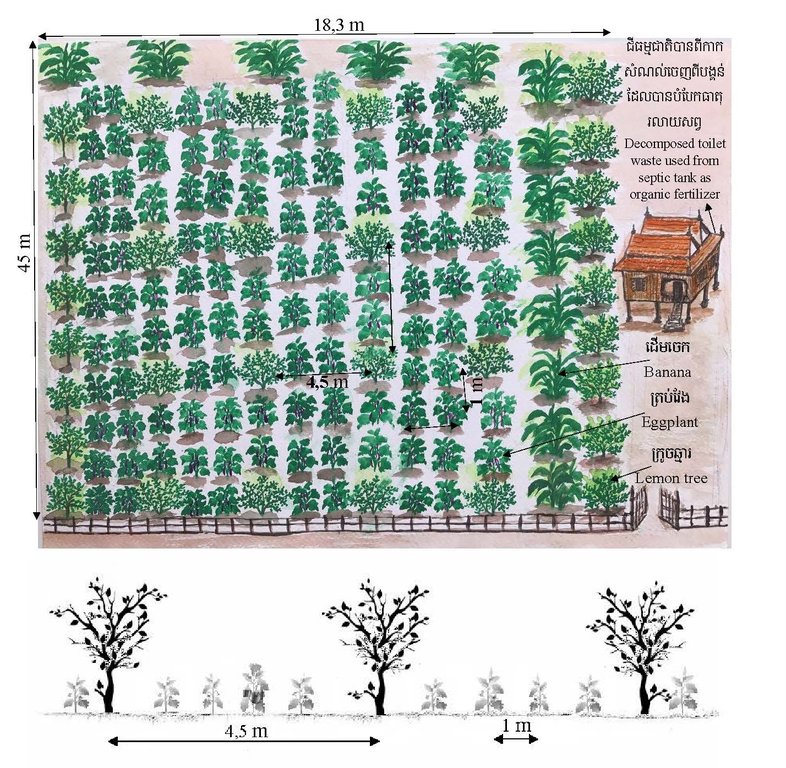Eggplant cultivation technique between lemon trees [Cambodia]
- Creation:
- Update:
- Compiler: Be Gechkim
- Editors: Sophea Tim, Navin Chea, Sok Pheak
- Reviewers: SO Than, Ursula Gaemperli
Mixed cropping
technologies_3153 - Cambodia
View sections
Expand all Collapse all1. General information
1.2 Contact details of resource persons and institutions involved in the assessment and documentation of the Technology
Key resource person(s)
land user:
Sokhom Oem
(+855) 88 25 35 216 / (+855) 89 69 15 52
N/A
Farmer
Svay Sa village, Khnach Romeas commune, Bavel district, Battambang province
Cambodia
Agricultural Extension Official at District Office of Agriculture, Forestry and Fisheries, Thma Koul:
Dara Phusar Siv
(+855) 12 501 462
N/A
District Office of Agriculture, Forestry and Fisheries, Thma Koul
Kaksekam village, Ta Pung commune, Thma Koul district, Battambang province
Cambodia
Chief of Agricultural Extension Official at District Office of Agriculture, Forestry and Fisheries, Sankae:
Chantha Chheam
(+855) 92 571 228
N/A
District Office of Agriculture, Forestry and Fisheries, Sankae
Boeng Beng village, Anlong Vil commune, Sankae district, Battambang province
Cambodia
Agronomy Official at District Office of Agriculture, Forestry and Fisheries, Bavel:
Larm Mout
(+855) 88 375 50 06
N/A
District Office of Agriculture, Forestry and Fisheries, Bavel
Tumnob Tuek village, Bavel commune, Bavel district, Battambang province
Cambodia
Name of project which facilitated the documentation/ evaluation of the Technology (if relevant)
Scaling-up SLM practices by smallholder farmers (IFAD)Name of the institution(s) which facilitated the documentation/ evaluation of the Technology (if relevant)
Royal University of Agriculture (RUA) - Cambodia1.3 Conditions regarding the use of data documented through WOCAT
When were the data compiled (in the field)?
30/06/2017
The compiler and key resource person(s) accept the conditions regarding the use of data documented through WOCAT:
Yes
1.4 Declaration on sustainability of the described Technology
Is the Technology described here problematic with regard to land degradation, so that it cannot be declared a sustainable land management technology?
No
2. Description of the SLM Technology
2.1 Short description of the Technology
Definition of the Technology:
Eggplant cultivation between lemon trees using restroom and crop residues as a source of soil nutrients instead of being reliant on the use of chemical fertilizers.
2.2 Detailed description of the Technology
Description:
Growing short-term crops or vegetables like eggplants and other crops between long-term crops belongs to the category of intercropping system. In case the farmer plants trees like lemon trees as long-term crop it can further be declared as agroforestry system. One important reason why farmers grow both, long-term and short-term crops on the same plot is to optimize the use of land resources. Another reason is that the short-term crops offer the opportunity to generate income to the farmers long before the long-term crop is productive.
These were also among the main reasons why Mr. Sokhom Oem from Svay sa village, Khnach romeas commune, Bavel district, Battambang province (the north-western province of Cambodia). He changed from mono-cropping to the intercropping system in 2016. His farm is connected to very deep alluvial soils (pH=5) with high topsoil organic matter and medium soil texture. The average annual rainfall in the region is 1100 mm. On a flat plot of 325.5 square meters (18.3 x 45 meters), he planted 10 lines of lemon trees (4 lemon trees per line). The space between each lemon tree is 4.5 x 4.5 meters. On his first year in December, after plowing and drying the soil, he planted eggplants at a distance of 80 to 100 cm on 40 rows between the lemon trees (16 plants per row = 640 plants). The reason why many farmers potentially prefer eggplants as an intercrop is that it can be grown as a yearlong crop that provides an initial fruit harvest only after one month of planting. After first harvest they continue to bear fruit during the whole year long. A fact that is very appreciated by the farmer, as this kind of plant does not require lots of work. Nevertheless, the productivity of the intercropped eggplant depends on its maintenance. Old leaves need to be removed when the plant has few flowers (General Directorate of Agriculture, 2012). After the eggplant cultivation the farmer can change to other intercrop vegetable if he likes. Lemon trees, on the other hand, can take up to three years before they produce fruit for harvest, after which they can be harvested continuously during 8 to 10 years. Sometimes trees can provide fruit during the whole year, but their productivity depends on sufficient water supply during the period from flowering to harvest. All in all, while waiting for full lemon yield the eggplants are an early and secure source of income. A further advantage to be mentioned is that eggplants improve the soil cover that protects from weed growing and in consequence eases the land management.
Besides the optimal use of the land, this technology also maintains and improves soil quality through the use of toilet residues. Only well decomposed liquid toilet waste (without a strong smell) is used in the form of a mixture of urine and feces which is drained from the septic tank. The application of this organic waste is based on the application of between 300-400 mm per lemon tree, after which normal watering is practiced. This liquid toilet waste is applied again when an intercrop like eggplants are producing less harvestable fruit. The intercrop plant residues are also kept as soil cover between the lemon trees, to provide more organic instead of using chemical fertilizer. The intercrop residues also help maintain the soil moisture content.
At some time after the initial adoption of this intercropping technology including the use of organic residues, land users understand the need for maintenance rather than anticipating ongoing long-term benefits after the immediate benefits. For example, the watering of the intercropped eggplants and of the lemon trees needs to be maintained in order to maintain their productivity. It is noted that farmers are able to achieve better and more sustainable incomes from the intercropping when compared with their previous practice of single cropping with corn or in the case of this study site sugar cane.
2.3 Photos of the Technology
2.4 Videos of the Technology
Comments, short description:
N/A
Name of videographer:
N/A
2.5 Country/ region/ locations where the Technology has been applied and which are covered by this assessment
Country:
Cambodia
Region/ State/ Province:
Svay Sa village, Khnach Romeas commune, Bavel district, Battambang province
Map
×2.6 Date of implementation
Indicate year of implementation:
2016
If precise year is not known, indicate approximate date:
- less than 10 years ago (recently)
2.7 Introduction of the Technology
Specify how the Technology was introduced:
- through land users' innovation
Comments (type of project, etc.):
Purpose was to generated higher incomes and reduce expenditures for fertilizers or plastic mulch.
3. Classification of the SLM Technology
3.1 Main purpose(s) of the Technology
- improve production
- reduce, prevent, restore land degradation
- create beneficial economic impact
3.2 Current land use type(s) where the Technology is applied

Mixed (crops/ grazing/ trees), incl. agroforestry
- Agroforestry
Main products/ services:
Eggplants and lemon trees
If land use has changed due to the implementation of the Technology, indicate land use before implementation of the Technology:
Before the land was cultivated by sugar cane (mono-cropping)
3.3 Further information about land use
Water supply for the land on which the Technology is applied:
- mixed rainfed-irrigated
Comments:
Using water from well
Number of growing seasons per year:
- 1
Specify:
He will rotate to other crops after eggplants between lemon trees.
3.4 SLM group to which the Technology belongs
- agroforestry
- improved ground/ vegetation cover
- integrated soil fertility management
3.5 Spread of the Technology
Specify the spread of the Technology:
- evenly spread over an area
If the Technology is evenly spread over an area, indicate approximate area covered:
- < 0.1 km2 (10 ha)
3.6 SLM measures comprising the Technology

agronomic measures
- A1: Vegetation/ soil cover
- A2: Organic matter/ soil fertility

vegetative measures
3.7 Main types of land degradation addressed by the Technology

chemical soil deterioration
- Cn: fertility decline and reduced organic matter content (not caused by erosion)

biological degradation
- Bq: quantity/ biomass decline

water degradation
- Ha: aridification
3.8 Prevention, reduction, or restoration of land degradation
Specify the goal of the Technology with regard to land degradation:
- prevent land degradation
4. Technical specifications, implementation activities, inputs, and costs
4.1 Technical drawing of the Technology
4.2 Technical specifications/ explanations of technical drawing
This technology is applied on 823,5 square meters of land (18,3 meters x 45 meters) which contains 10 lines of lemon trees with 4 trees per line. The space between each lemon tree is 4,5 x 4,5 meters. For planting the trees the pit size is 15 square cm in area and 20 cm in depth. The normal space between the eggplant is 80 to 100 cm. On 40 lines - each line contains 16 plants - 640 eggplants are planted. Custard apples and bananas can also be grown in the surrounding area. On the other hand, this technology also maintains and improves soil quality through the use of toilet residues. Only well decomposed liquid toilet waste (without a strong smell) is used in the form of a mixture of urine and feces which is drained from the septic tank.
4.3 General information regarding the calculation of inputs and costs
Specify how costs and inputs were calculated:
- per Technology area
Indicate size and area unit:
823,5 square meters
other/ national currency (specify):
KHR (Riel)
Indicate exchange rate from USD to local currency (if relevant): 1 USD =:
4000.0
Indicate average wage cost of hired labour per day:
20000 Riel
4.4 Establishment activities
| Activity | Type of measure | Timing | |
|---|---|---|---|
| 1. | Plow and sundry the soil | Agronomic | October |
| 2. | Lemon trees propagation (marcotting) | Vegetative | October |
| 3. | Lemon tree plantation | Vegetative | November |
4.5 Costs and inputs needed for establishment
| Specify input | Unit | Quantity | Costs per Unit | Total costs per input | % of costs borne by land users | |
|---|---|---|---|---|---|---|
| Labour | Plow and sundry the soil | person-day | 6.0 | 20000.0 | 120000.0 | 100.0 |
| Labour | Lemon tree propagation (marcotting) | person-day | 1.0 | 20000.0 | 20000.0 | 100.0 |
| Labour | Dig the hole for lemon tree planting | person-day | 1.0 | 20000.0 | 20000.0 | 100.0 |
| Equipment | Drilled well (motor pump included) | set | 1.0 | 750000.0 | 750000.0 | 100.0 |
| Equipment | Hoe | piece | 2.0 | 20000.0 | 40000.0 | 100.0 |
| Equipment | Spade | piece | 1.0 | 15000.0 | 15000.0 | 100.0 |
| Equipment | Two handle basket (to carry the soil) | pair | 1.0 | 15000.0 | 15000.0 | 100.0 |
| Plant material | Lemon tree | tree | 36.0 | 5000.0 | 180000.0 | 100.0 |
| Plant material | Eggplant seeds | package | 2.0 | 50000.0 | 100000.0 | 100.0 |
| Construction material | Watering tank | pair | 2.0 | 25000.0 | 50000.0 | 100.0 |
| Construction material | Pipe | meter | 40.0 | 12000.0 | 480000.0 | 100.0 |
| Total costs for establishment of the Technology | 1790000.0 | |||||
4.6 Maintenance/ recurrent activities
| Activity | Type of measure | Timing/ frequency | |
|---|---|---|---|
| 1. | Eggplant nursery | Vegetative | November |
| 2. | Plow and sundry the soil | Agronomic | December |
| 3. | Eggplant plantation | Agronomic | December |
| 4. | Watering lemon trees | Management | Watering only in dry season |
| 5. | Spraying botanical pesticide | Agronomic | Applied when insects appeared |
| 6. | Application of restroom residues ( on ground of lemon trees) | Agronomic | 2 times/ year |
| 7. | Watering the crops | Management | Watering a times/3 days to 7 days |
| 8. | Application of restroom residue (eggplants) | Agronomic | When fruit is reduced or leaves appear unusual signs as yellow leaves |
| 9. | Application of pesticide to the eggplants | Agronomic | 2 times/ week |
4.7 Costs and inputs needed for maintenance/ recurrent activities (per year)
| Specify input | Unit | Quantity | Costs per Unit | Total costs per input | % of costs borne by land users | |
|---|---|---|---|---|---|---|
| Labour | Eggplant nursery and plantation | person-day | 2.5 | 20000.0 | 50000.0 | 100.0 |
| Labour | Watering lemon trees | person-day | 26.0 | 20000.0 | 520000.0 | 100.0 |
| Labour | Pesticide spraying | person-day | 78.75 | 20000.0 | 1575000.0 | 100.0 |
| Labour | Application of fertilizer | person-day | 3.0 | 20000.0 | 60000.0 | 100.0 |
| Plant material | Eggplant seeds | package | 2.0 | 50000.0 | 100000.0 | 100.0 |
| Fertilizers and biocides | Pesticide (worm) | bottle | 2.0 | 25000.0 | 50000.0 | 100.0 |
| Fertilizers and biocides | Pesticide (vegetable louse) | bottle | 2.0 | 25000.0 | 50000.0 | 100.0 |
| Total costs for maintenance of the Technology | 2405000.0 | |||||
Comments:
Eggplants can be harvested after 1,5 months and provide further yield during the next 12 month, if the maintenance is good.
4.8 Most important factors affecting the costs
Describe the most determinate factors affecting the costs:
The organical pesticide application to the eggplants is most cost-relevant.
5. Natural and human environment
5.1 Climate
Annual rainfall
- < 250 mm
- 251-500 mm
- 501-750 mm
- 751-1,000 mm
- 1,001-1,500 mm
- 1,501-2,000 mm
- 2,001-3,000 mm
- 3,001-4,000 mm
- > 4,000 mm
Specify average annual rainfall (if known), in mm:
1102.02
Specifications/ comments on rainfall:
The annual rainfall in 2015 is 1102.02 mm. In 2014 is 878.13 mm and in 2013 is 1393 mm.
Indicate the name of the reference meteorological station considered:
Ministry of Water Resources and Meteorology (2015)
Agro-climatic zone
- sub-humid
5.2 Topography
Slopes on average:
- flat (0-2%)
- gentle (3-5%)
- moderate (6-10%)
- rolling (11-15%)
- hilly (16-30%)
- steep (31-60%)
- very steep (>60%)
Landforms:
- plateau/plains
- ridges
- mountain slopes
- hill slopes
- footslopes
- valley floors
Altitudinal zone:
- 0-100 m a.s.l.
- 101-500 m a.s.l.
- 501-1,000 m a.s.l.
- 1,001-1,500 m a.s.l.
- 1,501-2,000 m a.s.l.
- 2,001-2,500 m a.s.l.
- 2,501-3,000 m a.s.l.
- 3,001-4,000 m a.s.l.
- > 4,000 m a.s.l.
Indicate if the Technology is specifically applied in:
- not relevant
5.3 Soils
Soil depth on average:
- very shallow (0-20 cm)
- shallow (21-50 cm)
- moderately deep (51-80 cm)
- deep (81-120 cm)
- very deep (> 120 cm)
Soil texture (topsoil):
- medium (loamy, silty)
Soil texture (> 20 cm below surface):
- medium (loamy, silty)
Topsoil organic matter:
- high (>3%)
If available, attach full soil description or specify the available information, e.g. soil type, soil PH/ acidity, Cation Exchange Capacity, nitrogen, salinity etc.
Alluvial soil with pH= 5.
5.4 Water availability and quality
Ground water table:
5-50 m
Availability of surface water:
poor/ none
Water quality (untreated):
good drinking water
Is water salinity a problem?
No
Is flooding of the area occurring?
No
5.5 Biodiversity
Species diversity:
- low
Habitat diversity:
- low
Comments and further specifications on biodiversity:
N/A
5.6 Characteristics of land users applying the Technology
Sedentary or nomadic:
- Sedentary
Market orientation of production system:
- commercial/ market
Off-farm income:
- > 50% of all income
Relative level of wealth:
- average
Individuals or groups:
- individual/ household
Level of mechanization:
- manual work
Gender:
- men
Age of land users:
- middle-aged
Indicate other relevant characteristics of the land users:
The farmer is 53 years old.
5.7 Average area of land owned or leased by land users applying the Technology
- < 0.5 ha
- 0.5-1 ha
- 1-2 ha
- 2-5 ha
- 5-15 ha
- 15-50 ha
- 50-100 ha
- 100-500 ha
- 500-1,000 ha
- 1,000-10,000 ha
- > 10,000 ha
Is this considered small-, medium- or large-scale (referring to local context)?
- medium-scale
Comments:
Cropping land is 18,3 x 45 meters = 823,5 square meters and brother's land is 40 x 40 meters = 1600 square meters
5.8 Land ownership, land use rights, and water use rights
Land ownership:
- individual, titled
Land use rights:
- individual
Water use rights:
- individual
Comments:
The land user has a well for personal use.
5.9 Access to services and infrastructure
health:
- poor
- moderate
- good
education:
- poor
- moderate
- good
technical assistance:
- poor
- moderate
- good
employment (e.g. off-farm):
- poor
- moderate
- good
markets:
- poor
- moderate
- good
energy:
- poor
- moderate
- good
roads and transport:
- poor
- moderate
- good
drinking water and sanitation:
- poor
- moderate
- good
financial services:
- poor
- moderate
- good
6. Impacts and concluding statements
6.1 On-site impacts the Technology has shown
Socio-economic impacts
Production
crop production
Comments/ specify:
Crop production increased because previously he planted only one crop, but now he plants other crops between long term crops in addition.
crop quality
Comments/ specify:
The quality of the crop is better because he uses waste from the restroom with crop residues. This has replaced the chemical fertilizer.
risk of production failure
Comments/ specify:
He grows more than one crop, so if there is any problem with one crop, he can get income from the other crop.
product diversity
Comments/ specify:
Now he cultivates more different crops than before.
production area
Comments/ specify:
The production area increased slightly in the sense that he optimized the use of the existing farm area.
land management
Comments/ specify:
He cultivates vegetables with long-term crops using toilet residues.
Income and costs
expenses on agricultural inputs
Comments/ specify:
Before he used only chemical fertilizer.
farm income
Comments/ specify:
Between the lemon trees, a large amount of crops (vegetable) has been cultivated, that generates better farm income.
diversity of income sources
Comments/ specify:
Before only the lemon trees produced fruits, now he can get income from the crops between them.
economic disparities
Comments/ specify:
The income of the farmer has increased and therefore his economic situation has been improved.
workload
Comments/ specify:
He has more work to do, but it is less difficult than before.
Socio-cultural impacts
food security/ self-sufficiency
Comments/ specify:
Now he gets daily income from the crops.
health situation
Comments/ specify:
Better than at previous time because instead of using chemical fertilizer, now he uses fertilizer from decomposed toilet waste which is mixed with crops residues.
SLM/ land degradation knowledge
Comments/ specify:
During the first year of application he learned constantly how to better handle and maintain the eggplants cultivation.
Ecological impacts
Water cycle/ runoff
evaporation
Comments/ specify:
The land is now covered permanentely with plants what has reduced the evaporation much.
Soil
soil moisture
Comments/ specify:
Soil moisture is better, due to the permanent soil cover by crops (shadow of the leaves).
soil cover
Comments/ specify:
Soil cover is increased by the regular crop production between the citrus trees.
soil crusting/ sealing
Comments/ specify:
The application of decomposed toilet waste and eggplant residues on the topsoil reduced soil sealing substantially.
soil compaction
Comments/ specify:
Soil compaction has been reduced due to using waste from the and crops residue instead of chemical fertilizers.
soil organic matter/ below ground C
Comments/ specify:
Soil organic matter is increased due to the use of waste from septic tank and other crop residues.
Biodiversity: vegetation, animals
Vegetation cover
Comments/ specify:
There is continoued cropping after harvest.
plant diversity
Comments/ specify:
Crop types are changed regularly.
invasive alien species
Comments/ specify:
Because of better weed control due to better plant cover by crops, the invasive alien species were slightly reduced.
beneficial species
Comments/ specify:
There are many earthworms determined after the application of toilet residue instead of chemical fertilizer.
pest/ disease control
Comments/ specify:
On the one hand eggplants need a lot of pest and disease control, as they are sensitive to pest infestation. On the other the smell of the lemon trees might hinder the invasion of particular harmful organisms. The trees also attract birds that lives from insects.
Climate and disaster risk reduction
micro-climate
Comments/ specify:
The shadow of the trees, the different height of the plants, and the higher density of plants surrounding the plot (banana plants) influenced the micro-climate to the better (windbreak, balanced heat).
6.2 Off-site impacts the Technology has shown
Comments regarding impact assessment:
There was no considerable off-site effect detected.
6.3 Exposure and sensitivity of the Technology to gradual climate change and climate-related extremes/ disasters (as perceived by land users)
Gradual climate change
Gradual climate change
| Season | Type of climatic change/ extreme | How does the Technology cope with it? | |
|---|---|---|---|
| annual temperature | increase | well | |
| seasonal rainfall | wet/ rainy season | increase | well |
Climate-related extremes (disasters)
Climatological disasters
| How does the Technology cope with it? | |
|---|---|
| drought | very well |
Biological disasters
| How does the Technology cope with it? | |
|---|---|
| epidemic diseases | moderately |
6.4 Cost-benefit analysis
How do the benefits compare with the establishment costs (from land users’ perspective)?
Short-term returns:
positive
Long-term returns:
positive
How do the benefits compare with the maintenance/ recurrent costs (from land users' perspective)?
Short-term returns:
positive
Long-term returns:
positive
6.5 Adoption of the Technology
- single cases/ experimental
Of all those who have adopted the Technology, how many have did so spontaneously, i.e. without receiving any material incentives/ payments?
- 90-100%
Comments:
No other family wants to apply this technology.
6.6 Adaptation
Has the Technology been modified recently to adapt to changing conditions?
No
6.7 Strengths/ advantages/ opportunities of the Technology
| Strengths/ advantages/ opportunities in the land user’s view |
|---|
| Continued profitability of the land from the diversification of crops being grown. |
| It is easy to take care of the crops and the lemon trees also benefit from the labour input from watering the eggplants, as the water applied also helps to meet the needs of the lemon trees. |
| The technology is also adaptive to a strong sunlight and heat. |
| Strengths/ advantages/ opportunities in the compiler’s or other key resource person’s view |
|---|
| Improves the soil nutrient level and availability based on the crop rotation and the use of restroom residues. |
| Reduces the cost of chemical fertilizers and other inputs. |
| Maintains soil moisture and reduces labor input required for watering and/or weeding. |
| The use of cover crops reduces potential weed competition. |
6.8 Weaknesses/ disadvantages/ risks of the Technology and ways of overcoming them
| Weaknesses/ disadvantages/ risks in the land user’s view | How can they be overcome? |
|---|---|
| Some problems with disease and insects | Application of appropriate and technically recommended pesticide. |
| Lack of natural pesticide techniques for prevention and control insects. | Seek support in the form of instructions and/or short-term training. |
7. References and links
7.1 Methods/ sources of information
- field visits, field surveys
A place
- interviews with land users
A person
- interviews with SLM specialists/ experts
3 people
7.3 Links to relevant information which is available online
Title/ description:
General Directorate of Agriculture (2012) Vegetable techniques. (In Khmer)
URL:
Retrieved on Aug 2017 from https://drive.google.com/file/d/0B41jxuufJz2-Y1c1bHpNb2ZpMm8/view
Title/ description:
My Agriculture Information Bank (2015) Inter Cropping and Its Advantages. My Agriculture Information Bank. Retrieved on July 25 2017 from
URL:
http://www.agriinfo.in/?page=topic&superid=1&topicid=492
Links and modules
Expand all Collapse allLinks
No links
Modules
No modules


